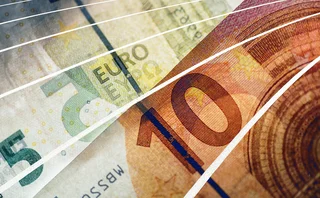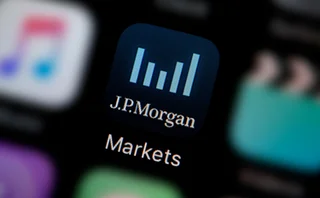
Primary dealers lose derivatives market-share, says BIS triennial survey
Trading in over-the-counter currency and interest rate derivatives has risen by 112% since 2001, but the market-share of reporting dealers has fallen, according to the latest survey conducted by the Bank for International Settlements (BIS).
This is matched by a rise in derivatives use by smaller commercial banks, mutual funds, hedge funds and insurance companies, which the survey attributes to the turbulent nature of financial markets since 2001. The market-share of these non-reporting financial institutions rose to 43% of OTC turnover, up from 29% in 2001, leaving them similar in size to the reporting dealers. The remainder of the market represents end-users such as corporates and governments, which have seen their share of activity increase by 216% to $79 billion.
The survey, which uses trading data supplied by central banks from April, shows daily average trading volumes reaching $1.2 trillion, a figure that includes all OTC currency swaps and options, and interest rate derivatives.
Exchange-traded derivatives volumes rose by a similar amount: 120% for currency derivatives and 108% for interest rate derivatives. The survey claims the OTC market’s increase reflects broader market factors rather than a shift away from exchange trading.
Interest rate contracts, the largest sector of the OTC derivatives market, grew in volume by 110%, boosted by a 128% rise in US dollar-denominated activity. Interest rate options now represent 17% of the market, tripling in size since 2001. Trading in forward-rate agreements (FRAs) and interest rate swaps roughly doubled for both instruments. The increases in interest rate derivatives trading can be partially explained by the shift in expectation about future US interest rates during April. US dollar-denominated options grew considerably to reach $91 billion, a rise of 675%.
Interest rate contracts denominated in euros rose by 100%, with euro options showing a 500% increase to reach $57 billion, up from $11 billion in 2001. Euro interest rate swaps, the benchmark for European fixed income due to the absence of homogeneous government bond markets, grew by 66%. Euro-denominated interest rate derivatives volumes are larger than dollar volumes – $461 billion compared with $347 billion – as was the case in 2001. The survey attributes part of the increase in euro derivatives volumes to the 25% depreciation of the dollar against the euro since the BIS’ last triennial survey.
Japanese economic recovery and its associated shift in interest rate expectations has boosted yen interest rate swap trading, which recovered from its drop in 2001 to reach daily volumes of $35 billion, a 119% rise. Meanwhile, sterling interest rate swap trading was up 157% to $59 billion a day, while overall sterling interest rate derivatives trading grew 143% to $90 billion.
In the foreign exchange markets, derivatives trading was up 109% to $140 billion, although the sector’s total share of the OTC derivatives market remained fairly static at 12%. Trading was boosted by dollar contracts, especially dollar/euro and dollar/yen pairings, up 124% and 58% respectively. Turnover for other euro-denominated contracts rose 130% to $23 billion. Currency options, the largest group of non-traditional foreign exchange products, exhibited a trading increase of 95% to $117 billion. Currency swaps trading hit $21 billion, up 200%.
Cross-border activity now accounts for 60% of all trading, continuing its steady rise from 52% in 1998.
The survey is conducted every three years by the Basel-based BIS, which collects data from 52 central banks and monetary authorities on traditional foreign exchange market turnover, as well as interest rate and currency derivatives.
Only users who have a paid subscription or are part of a corporate subscription are able to print or copy content.
To access these options, along with all other subscription benefits, please contact info@risk.net or view our subscription options here: http://subscriptions.risk.net/subscribe
You are currently unable to print this content. Please contact info@risk.net to find out more.
You are currently unable to copy this content. Please contact info@risk.net to find out more.
Copyright Infopro Digital Limited. All rights reserved.
You may share this content using our article tools. Printing this content is for the sole use of the Authorised User (named subscriber), as outlined in our terms and conditions - https://www.infopro-insight.com/terms-conditions/insight-subscriptions/
If you would like to purchase additional rights please email info@risk.net
Copyright Infopro Digital Limited. All rights reserved.
You may share this content using our article tools. Copying this content is for the sole use of the Authorised User (named subscriber), as outlined in our terms and conditions - https://www.infopro-insight.com/terms-conditions/insight-subscriptions/
If you would like to purchase additional rights please email info@risk.net
More on Markets
Buy side would welcome more guidance on managing margin calls
FSB report calls for regulators to review existing standards for non-bank liquidity management
Citi halves swaptions book with US retail funds
Counterparty Radar: Mutual funds and ETFs cut exposures by 22% in Q4
Who’s winning the €STR futures race? Depends how you measure
CME, Eurex and Ice all claim to be leading, but experts say it’s too early to pick a winner
CDS review seeks to tackle conflicts ‘elephant’
Isda AGM: Linklaters proposes overhaul for determinations committee - including independent members
Saudi Arabia poised to become clean netting jurisdiction
Isda AGM: Netting regulation awaiting final approvals from regulators
Buy side looks to fill talent gap in yen rates trading
Isda AGM: Japan rate rises spark demand for traders; dealers say inexperience could trigger volatility
JP Morgan’s new way to trade FX overlays
Hybrid execution method allows clients to put dealers in competition via a single trading agreement
Pension funds eye 30-year Bunds as swap spread tightens
Long-dated bonds continue to cheapen versus euro swaps, and some think they might fall further







